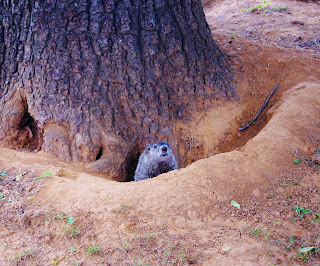In the run up to the Civil War, Montgomery County developed a reputation as a pro-slavery area. This wasn't necessarily out of step with Maryland in general given it is below the Mason-Dixon line and was a slave holding state. One of the big reasons Maryland didn't secede turned out to be the small matter of Abraham Lincoln throwing 13 pro-South state delegates in the slammer just before a crucial vote on the manner.
However, as with everywhere else in the country, things were never cut and dried. While most residents supported the South, the Quakers didn't. They settled in the Sandy Spring area around 1745 and by 1777, they decided slavery was immoral and freed their slaves. This created a community of freed blacks and Quakers right in the heart of Montgomery County and, as these things happen, set up a crucial stop on the Underground Railroad that smuggled escaped slaves North.
What Sandy Spring turns into below
 Now I don't know if it is true and apparently neither does the Montgomery County park service, but the story is that one of the former slaves that hid in the Sandy Spring area was none other than Dred Scott, the slave who claimed his freedom after reaching the North. The Supreme Court ruled against him, which didn't mollify the South, but did succeed in enraging much of the North.
Now I don't know if it is true and apparently neither does the Montgomery County park service, but the story is that one of the former slaves that hid in the Sandy Spring area was none other than Dred Scott, the slave who claimed his freedom after reaching the North. The Supreme Court ruled against him, which didn't mollify the South, but did succeed in enraging much of the North.At Woodlawn Manor Park, the county has set up a two-mile interpretative trail which points out some of the aspects of the Underground Railroad such as hiding out and following the North Star at night. This 2 mile trail wasn't an actual Underground Railroad trail. No such thing exists. It's just supposed to show how it worked. In their description, the park service refers to "rumors" Dred Scott hid in Sandy Spring. A quick web search of Maryland archives also cites "tales" of Dred Scott being somewhere or another in Montgomery County under the protection of the Howard family. What is clear is that Montgomery County supported a thriving community of slave-catchers since our northern state line is the split between North and South.
History aside, this walk is roughly split between a mile in the woods and mile along and between cornfields. If you want to get a glimpse of what the county looked like a hundred years ago, this is about as good a place as any to do so.
A beautiful and highly unusual stone barn built in the 1830s. Most were of wood but this was built to last. Now it houses park service horses at Woodlawn Manor.
This Groundhog has his own underground railway.
Practical information: Drive to 16501 Norwood Road, Sandy Springs, Md, to find the entrance to the Woodlawn Manor Park. The underground railway interpretative trail starts to the right of the main parking lot. On weekends, guides give free tours and talks of the trail.
Trail length is 2 miles, round trip 4 miles.






















































